SDG 17 – “Strengthen the means of implementation and revitalize the global partnership for sustainable development” – is made up of 19 targets and 25 indicators. It covers the elements making up means of implementation: finance (17.1-17.5), technology (17.6-17.8), capacity-building (17.9), trade (17.10-17.12), and systemic issues (17.13-17.19).
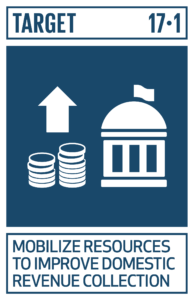
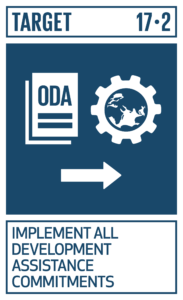
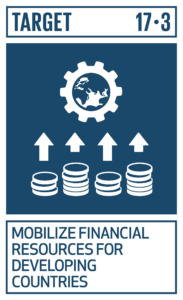
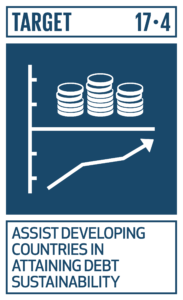
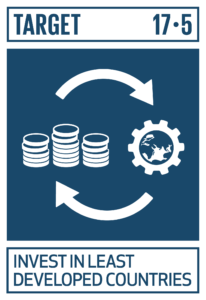
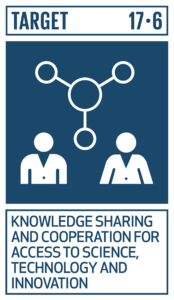
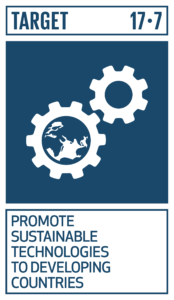
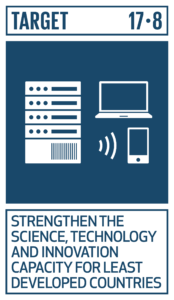
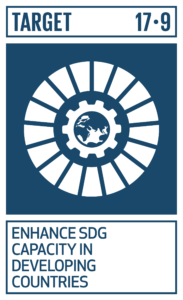
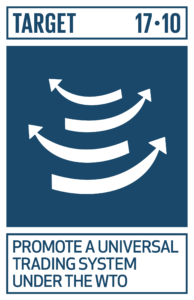
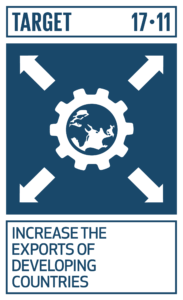
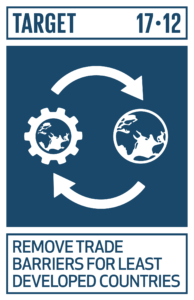
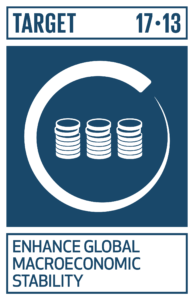
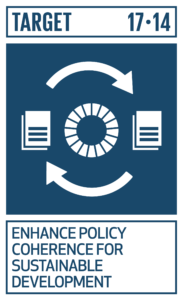
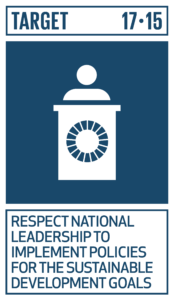
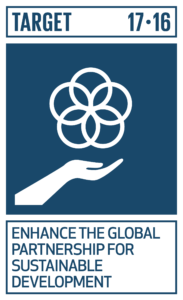
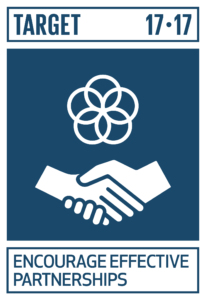
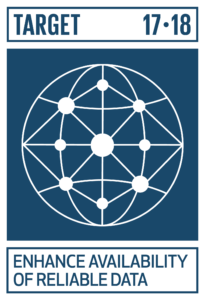
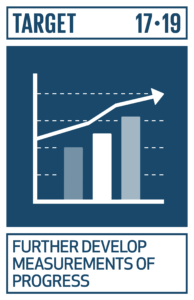
SDG 17 is reviewed annually at the High-Level Political Forum.
Context
The term “partnerships” is used in two ways in the 2030 Agenda for Sustainable Development. The first is Global Partnership, which refers to working in global solidarity in order to facilitate global engagement in the implementation of the SDGs and bringing together government, civil society, private sector, the United Nations system, and other actors.1 The second way is as a means of implementation through multi-stakeholder partnerships, which are “voluntary and collaborative relationships between various parties, both State and non-State, in which all participants agree to work together to achieve a common purpose or undertake a specific task and to share risks and responsibilities, resources and benefits”.2 While separate ideas, both usages are interlinked, with multi-stakeholder partnerships seen as a way of achieving the Global Partnership and a complement to government efforts and the support of development assistance.3
The idea of the Global Partnership is at the root of SDG 17, which has its origins in the Millennium Development Goal (MDG) 8: A Global Partnership for Development. It attempted to bridge the gap between principle and policy by focusing on trade, aid, debt relief and technology transfer and represented a big shift in the global framework of development. Understood as a way for keeping rich countries accountable, one critique was that it did not indicate what specific policy changes were required and lacked clarity in targets and indicators.4,5 There was also a lack of alignment between the goal and its targets.6 Ultimately, countries failed to meet MDG 8.
SDG 17 attempts to improve on MDG 8 by additionally targeting the systemic issues of policy and institutional coherence, data, and multi-stakeholder partnerships. It was developed to reflect a holistic approach to the means of implementation, in addition to supplementing means of implementation targets in the other 16 SDGs.7 Yet, SDG 17 is considered to suffer from the same lack of concrete responsibilities, despite a more robust system of targets and indicators.8 The voluntary approach may be insufficient for developing the number and types of collaborations required to create the necessary transformations.9 In addition, the linkages between SDG 17 and the other goals are inconsistent, as MOI elements of SDG 17 are not included consistently in the other goals, nor are partnerships mentioned outside of SDG 17.10
Regionalisation and localisation
UNESCAP’s role in the Asia-Pacific region is to promote cooperation among countries in the region to achieve inclusive and sustainable development, and aims to deliver on the 2030 Agenda by “promoting regional cooperation and integration to advance responses to shared vulnerabilities, connectivity, financial cooperation, and market integration”.11 The organization developed a Roadmap for Implementing the 2030 Agenda for Sustainable Development in Asia and the Pacific and has identified four priority areas for cooperation, one of which is the means of implementation and partnerships. In this regard it has engaged in activities on science, technology and innovation including policy advice and capacity building; conducted research and provided technical support on financing for development; is prepared to conduct policy and other analytical research on trade issues; and is committed to supporting partner countries in developing national statistical systems and providing regional indicator data and statistical information.12 For example, UNESCAP assisted four of the five LMCs (all except Thailand) in developing their national statistical systems.13 Another platform that UNESCAP has developed is the SDG Help Desk, as well as a rapid response facility for responding to requests for technical assistance, prioritizing requests from least developed countries like Lao PDR, Myanmar, Cambodia, while also supporting Vietnam and Thailand.14 UNESCAP has also partnered with Asian Development Bank (ADB) and UNDP to develop the Asia-Pacific SDG Partnership Data Portal. A set of guidelines on multi-stakeholder partnerships was also developed.15
ASEAN has indicated its support of the 2030 Agenda, although it has not developed any additional or specific policies regarding the implementation of SDGs. It has instead opted to indicate complementarities between its community policies and the SDGs. In this regard, ASEAN notes that multi-stakeholder collaborations are one the key underlying principles of their ASEAN Community Vision 2025.16
Means of implementation
As a goal specifically on means of implementation, SDG 17’s indicators do not distinguish between substantive and means of implementation, unlike the other goals. Thus, all the indicators of SDG 17 are discussed below.
Follow up and review, monitoring and evaluation
15/25 indicators are Tier I, meaning that the indicator is conceptually clear, has an internationally established methodology and data is regularly produced by 50% of countries and of the population of each region globally. The remainder are Tiers II and III, which mean that for 40% of indicators, data are not produced regularly.17 However, despite the global trend of a majority of indicators with data, the picture in Southeast Asia and the LMCs is different. UNESCAP reports that the Southeast Asia region has insufficient data for Targets 17.1-17.5, 17.7, and 17.10-17.18.18 UNESCAP reports that SDG 17 has been stagnant in the Southeast Asia region.19 Further, reported data may suffer from a lack of political independence.20
| Indicator | Tier | Custodian | Notes |
|---|---|---|---|
| 17.1.1 | I | IMF | |
| 17.1.2 | I | IMF | |
| 17.2.1 | I | OECD | |
| 17.3.1 | I | OECD, UNCTAD | |
| 17.3.2 | I | World Bank | |
| 17.4.1 | I | World Bank | |
| 17.5.1 | II | UNCTAD | |
| 17.6.1 | III | UNESCO-UIS | |
| 17.6.2 | II | ITU | |
| 17.7.1 | II | UNEP-CTCN | |
| 17.8.1 | I | ITU | |
| 17.9.1 | I | OECD | |
| 17.10.1 | I | WTO, ITC, UNCTAD | |
| 17.11.1 | I | WTO, ITC, UNCTAD | |
| 17.12.1 | I | WTO, ITC, UNCTAD | |
| 17.13.1 | II | World Bank | |
| 17.14.1 | III | UNEP | As at December 2019 still awaiting results of pilots to determine tier classification |
| 17.15.1 | II | OECD, UNDP | |
| 17.16.1 | II | OECD, UNDP | |
| 17.17.1 | III | World Bank | |
| 17.18.1 | III | UNSD | |
| 17.18.2 | I | PARIS21 | |
| 17.18.3 | I | PARIS21 | |
| 17.19.1 | I | PARIS21 | |
| 17.19.2 | I | UNSD |
Finance
Data is available for all the Lower Mekong Countries on four of the seven finance indicators (17.1.1: Total government revenue as a proportion of GDP; 17.1.2: proportion of domestic budget funded by tax; 17.3.2: Volume of remittances as a proportion of total GDP; 17.4.1: Debt service as a proportion of exports of goods and services). The data shows that the proportion of the domestic budget funded by taxes (17.1.2; 2017) ranges in the region, from almost 75% in Thailand and Cambodia, to 57% and 47% in Lao PDR and Myanmar, respectively. The most recent data available on Vietnam is from 2013, which shows 69%; however, the previous data point (2010) indicates that the proportion was 90%, which suggests that the missing data point cannot be approximated. The data on 17.4.1 (debt service as a proportion of exports of good and services) shows that in 2017, Thailand had the lowest proportion of debt service, at 0.2%, with Cambodia and Vietnam at just over 1%, Myanmar at 5% and Lao PDR at almost 9%. See the data here.
Indicators 17.1.1 and 17.3.2 are visualised below.
There is no data available for the remaining three (17.2.1: Net official development assistance; 17.3.1: Foreign direct investments, official development assistance and South-South cooperation as a proportion of total domestic budget; 17.5.1: Number of countries that adopt and implement investment promotion regimes for least developed countries). However, 17.2.1 is primarily relevant to Thailand only.
Technology
The indicators on technology partnerships (17.6.1: Number of science and/or technology coordination agreements and programmes between countries, by type of cooperation; 17.6.2: Fixed internet broadband subscriptions per 100 inhabitants, by speed; 17.7.1: total amount of approved funding for developing countries to promote the development, transfer, dissemination and diffusion of environmentally sound technologies; 17.8.1: proportion of individuals using the internet) are not as well-developed as others, with three of four without sufficient data, one of which is still undergoing methodological development (17.6.1), and only one with sufficient data (17.8.1).
In the LMCs, data is available for 17.6.2 and 17.8.1. Yet it is important to note that these indicators, as with many others, only represent a limited aspect of the relevant targets (17.6: Enhance North-South, South-South and triangular regional and international cooperation on and access to science, technology and innovation and enhance knowledge-sharing on mutually agreed terms, including through improved coordination among existing mechanisms, in particular at the United nations level, and through a global technology facilitation mechanism; 17.8: fully operationalize the technology bank and science, technology and innovation capacity-building mechanism for least developed countries by 2017, and enhance the use of enabling technology, in particular information and communications technology). See the chart below for a brief discussion of some limitations.
Capacity building
Capacity building has only a single target and indicator (17.9.1: Dollar value of financial and technical assistance committed to developing countries). However, dollars spent is only one measure of capacity building, and understanding actual change must go beyond a simple increase in resources and look to whether institutions themselves are stronger, better and more resilient.21
Trade
Of the three trade indicators (17.10.1: Worldwide weighted tariff, average; 17.11.1: Developing countries’ and least developed countries’ share of global exports; 17.12.1: Average tariffs faced by developing countries and small island developing States), data is available in the LMCs for two (17.10.1 and 17.12.1). Data on 17.10.1 and 17.12.1 are disaggregated by “type of product”, but it is unclear as to how the codes are defined, as this is not well-defined in the metadata. In addition, 17.12.1 benefits from the legacy of the MDGs and has been measured since 2000.
Systemic Issues (policy and institutional coherence; multi-stakeholder partnerships; and data, monitoring and accountability)
Data for all the LMCs is available for only indicators 17.18.3 (Number of countries with a national statistical plan that is fully funded and under implementation, by source of funding), 17.19.1 (Dollar value of all resources made available to strengthen statistical capacity in developing countries) and 17.19.2 (Proportion of countries that a) have conducted at least one population and housing census in the last 10 years and b) have achieved 100% birth registration and 80% death registration).
Data on 17.18.3 indicate that as at 2018 Cambodia had a national statistical plan that is funded by the government and donors but were not yet implemented; Lao PDR, Myanmar, Thailand and Vietnam had plans that were being implemented. Data from 17.19.2 also indicates that all countries have held a census (Cambodia in 2008; Lao PDR in 2015; Myanmar in 2014; Thailand in 2010; and Vietnam in 2009) and that all but Thailand are struggling with birth and death registration (data on Lao PDR is unavailable). See the dataset here.
Data from 17.19.1 is visualised below.
Partial data is available for 17.15.1 (Extent of use of country-owned results frameworks and planning tools by providers of development cooperation; available for Cambodia, Lao PDR, Myanmar and Vietnam); 17.16.1 (Number of countries reporting progress in multi-stakeholder development effectiveness monitoring frameworks that support the achievement of the sustainable development goals; available for Thailand and Vietnam only); and 17.18.2 (number of countries that have national statistical legislation that complies with the Fundamental Principles of Official Statistics; available for Cambodia and Thailand only).
The remaining indicators have no data. (17.13.1: Macroeconomic dashboard ; 17.14.1: Number of countries with mechanisms in place to enhance policy coherence of sustainable development; 17.17.1: Amount of United States dollars committed to public-private and civil society partnerships; 17.18.1: Proportion of sustainable development indicators produced at the national level with full disaggregation when relevant to the target, in accordance with the Fundamental Principles of Official Statistics)
References
- 1. United Nations. 2015. Transforming our world: The 2030 Agenda for Sustainable Development at Articles 39 and 60. Accessed February 18, 2020.
- 2. GUNi Group of Experts in SDGs and Higher Education. 2018. Approaches to SDG 17 Partnerships for the Sustainable Development Goals (SDGs). Accessed February 17, 2020.
- 3. Ibid at p. 37.
- 4. Sakiko Fukuda Parr. 2013. “Chapter 15: A right to development critique of Millennium Development Goal 8” in Realizing the Right to Development: Essays in Commemoration of 25 Years of United Nations Declaration on the Right to Development. Accessed February 14, 2020.
- 5. UN System Task Team on the Post-2015 UN Development Agenda. 2012. Review of the contributions of the MDG Agenda to foster development: lessons for the post-2015 UN development agenda. Accessed February 14, 2020.
- 6. Ibid.
- 7. High Level Political Forum on Sustainable Development. 2018. 2018 HLPF review of SDGs implementation: SDG 17 – Strengthen the means of implementation and the global partnership for sustainable development. Accessed February 14, 2020.
- 8. Thomas W Pogge and Mitu Sengupta. 2016. “Assessing the sustainable development goals from a human rights perspective” in Journal of International and Comparative Social Policy at pages 83-97. Accessed February 14, 2020.
- 9. David Horan. 2019. “A new approach to partnerships for SDG transformations” in Sustainability. Accessed February 18, 2020.
- 10. Mark Elder, Magnus Bengtssen and Lewis Akenji. 2016. “An optimistic analysis of the means of implementation for Sustainable Development Goals: Thinking about the Goals as means” in Sustainability. Accessed February 14, 2020.
- 11. UNESCAP. About UNESCAP. Accessed February 20, 2020.
- 12. UNESCAP. Means of Implementation. Accessed February 20, 2020.
- 13. UNESCAP. 2020. Advancing partnerships for the implementation of the regional road map for implementing the 2030 Agenda for Sustainable Development in Asia and the Pacific. Accessed February 21, 2020.
- 14. Ibid.
- 15. UNESCAP and UNU-IAS. 2018. Partnering for Sustainable Development: Guidelines for Multi-stakeholder Partnerships to Implement the 2030 Agenda in Asia and the Pacific. Accessed February 17, 2020.
- 16. UNESCAP, ASEAN. 2017. Complementarities between the ASEAN Community Vision 2025 and the United Nations 2030 Agenda for Sustainable Development: A Framework for Action. Accessed February 17, 2020.
- 17. IAEG-SDGs. IAEG-SDGs Tier Classification for Global SDG Indicators. Accessed February 18, 2020.
- 18. UNESCAP. 2019. Asia and the Pacific: SDG Progress Report 2019. Accessed February 14, 2020.
- 19. UNESCAP. 2020. Five years on: Where do we stand? Accessed February 21, 2020.
- 20. ADB. 2017. Key Indicators for Asia and the Pacific. Accessed February 17, 2020.
- 21. UNDP. 2015. Measuring Capacity. Accessed February 20, 2020.

